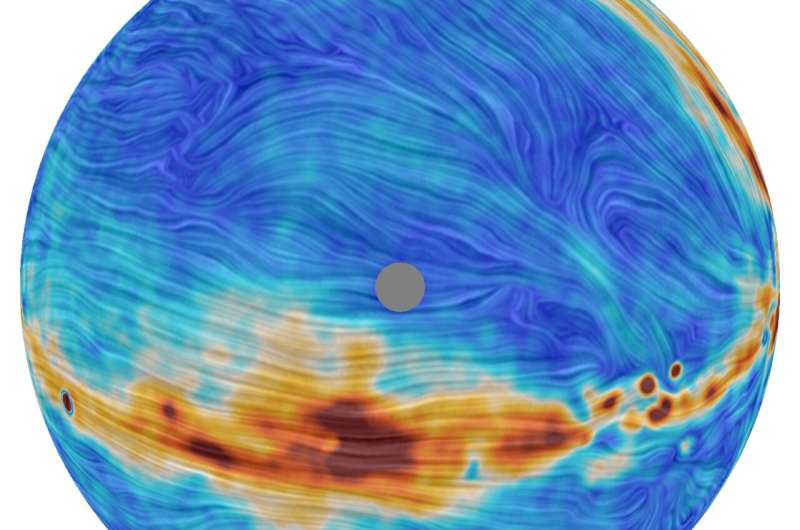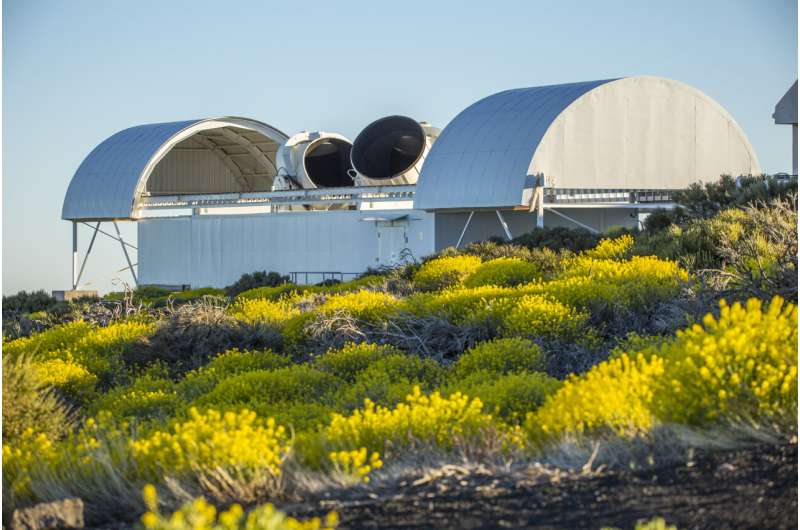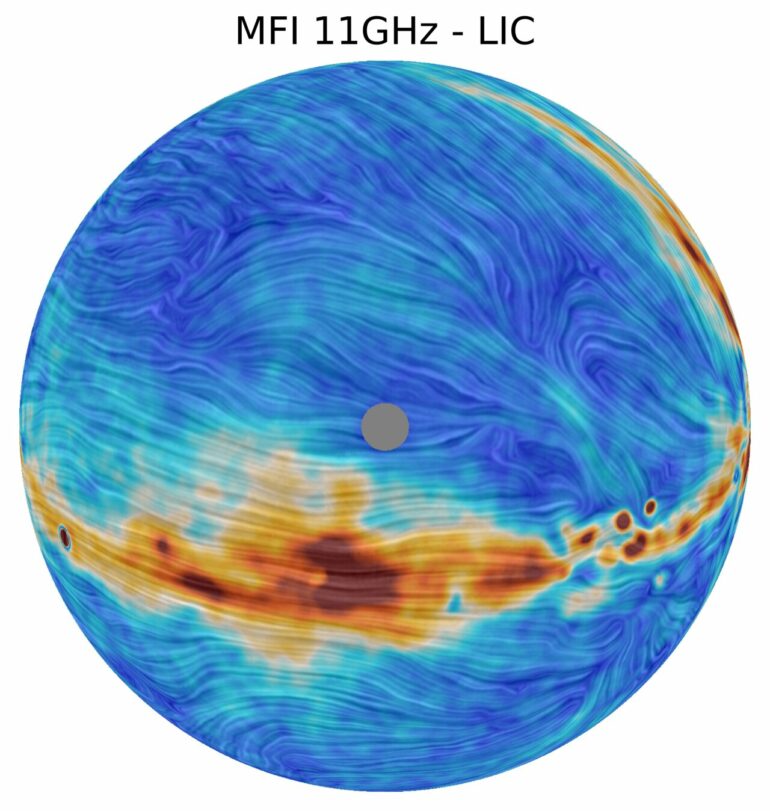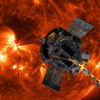An international team of scientists have successfully mapped the magnetic field of our galaxy, the Milky Way, using telescopes that observe the sky in the microwave range. The new research is published in Monthly Notices of the Royal Astronomical Society.
The team used the QUIJOTE (Q-U-I JOint TEnerife) Collaboration, sited at the Teide Observatory on Tenerife in the Canary Islands. This comprises two 2.5 m diameter telescopes, which observe the sky in the microwave part of the electromagnetic spectrum.
Led by the Instituto de Astrofísica de Canarias (IAC), the mapping began in 2012. Almost a decade later, the Collaboration has presented a series of 6 scientific articles, giving the most accurate description to date of the polarization of the emission of the Milky Way at microwave wavelengths. Polarization is a property of transverse waves such as light waves that specifies the direction of the oscillations of the waves and signifies the presence of a magnetic field.
The studies complement earlier space missions dedicated to the study of the cosmic microwave background radiation (CMB), the fossil radiation left behind by the Big Bang, which gave a detailed insight into the early history of the cosmos.

Map of polarized microwave emission in the northern hemisphere measured by QUIJOTE. The drapery pattern represents the direction of the Galactic magnetic field. The color scale represents the intensity of the emission. © QUIJOTE Collaboration
As well as mapping the magnetic structure of the Milky Way, the QUIJOTE data has also proved useful in other scenarios. The new data are also a unique tool for studying the anomalous microwave emission (AME), a type of emission first detected 25 years ago. AME is thought to be produced by the rotation of very small particles of dust in the interstellar medium, which tend to be oriented by the presence of the galactic magnetic field.
The new results allowed the team to obtain information about the structure of the magnetic field of the Milky Way, as well as helping to understand the energetic processes which took place close to the birth of the Universe. To measure signals from that time, scientists need to first eliminate the veil of emission associated with our own Galaxy. The new maps provided by QUIJOTE do just that, allowing us to better understand these elusive signals from the wider Universe.

QUIJOTE experiment at the Teide Observatory (Tenerife, Spain). © Daniel López / IAC
The maps from QUIJOTE have also permitted the study of a recently detected excess of microwave emission from the center of our Galaxy. The origin of this emission is currently unknown, but it could be connected to the decay processes of dark matter particles. With QUIJOTE, the team have confirmed the existence of this excess of radiation, and have found some evidence that it could be polarized.
Finally, the new maps from QUIJOTE have permitted the systematic study of over 700 sources of emission in radio and microwaves, of both Galactic and extragalactic origin, meaning that the data is helping scientists to decipher signals coming from beyond our galaxy, including the cosmic microwave background radiation.
“These new maps give a detailed description in a new frequency range, from 10 to 40 GHz, complementing those from space missions such as Planck and WMAP”, comments José Alberto Rubiño, lead scientist of the QUIJOTE Collaboration. “We have characterized the synchrotron emission from our Galaxy with unprecedented accuracy. This radiation is the result of the emission by charged particles moving at velocities close to that of light within the Galactic magnetic field. These maps, the result of almost 9,000 hours of observation, are a unique tool for studying magnetism in the universe” he adds.
“One of the most interesting results we have found is that the polarized synchrotron emission from our Galaxy is much more variable than had been thought” comments Elena de la Hoz, a researcher at the Instituto de Física de Cantabria (IFCA). “The results we have obtained are a reference to help future experiments make reliable detections of the CMB signal” she adds.
“Scientific evidence suggests that the Universe went through a phase of rapid expansion, called inflation, a fraction of a second after the Big Bang. If this is correct, we would expect to find some observable consequences when we study the polarization of the cosmic microwave background. Measuring those expected features is difficult, because they are small in amplitude, but also because they are less bright than the polarized emission from our own galaxy.” notes Rubiño, “However, if we finally measure them, we will have indirect information of the physical conditions in the very early stages of our Universe, when the energy scales were much higher than those that we can access or study from the ground. This has enormous implications for our understanding of fundamental physics.”
“The maps from QUIJOTE have also permitted the study of the microwave emission from the center of our Galaxy. Recently an excess of microwave emission has been detected from this region, whose origin is unknown, but whose origin could be connected to the decay processes of dark matter particles. With QUIJOTE we have confirmed the existence of this excess of radiation, and have found some evidence that it could be polarized” comments Federica Guidi, a researcher at the Institut d’Astrophysique de Paris (IAP, Francia).
The work appears in “QUIJOTE scientific results—IV. A northern sky survey in intensity and polarization at 10–20 GHz with the Multi-Frequency Instrument,” Rubiño-Martin et al., published in Monthly Notices of the Royal Astronomical Society.
More information:
J A Rubiño-Martín et al, QUIJOTE scientific results—IV. A northern sky survey in intensity and polarization at 10–20 GHz with the multifrequency instrument, Monthly Notices of the Royal Astronomical Society (2023). DOI: 10.1093/mnras/stac3439
Related papers:
D Herranz et al, QUIJOTE scientific results—IX. Radio sources in the QUIJOTE-MFI wide survey maps, Monthly Notices of the Royal Astronomical Society (2023). DOI: 10.1093/mnras/stac3657
D Tramonte et al, QUIJOTE scientific results—V. The microwave intensity and polarization spectra of the Galactic regions W49, W51 and IC443, Monthly Notices of the Royal Astronomical Society (2023). DOI: 10.1093/mnras/stac3502
F Guidi et al, QUIJOTE scientific results—VI. The Haze as seen by QUIJOTE, Monthly Notices of the Royal Astronomical Society (2023). DOI: 10.1093/mnras/stac3468
F Poidevin et al, QUIJOTE scientific results—VII. Galactic AME sources in the QUIJOTE-MFI northern hemisphere wide survey, Monthly Notices of the Royal Astronomical Society (2023). DOI: 10.1093/mnras/stac3151
E de la Hoz et al, QUIJOTE scientific results—VIII. Diffuse polarized foregrounds from component separation with QUIJOTE-MFI, Monthly Notices of the Royal Astronomical Society (2023). DOI: 10.1093/mnras/stac3020
Provided by
Royal Astronomical Society
Citation:
Astronomers create new microwave map of the Milky Way and beyond (2023, January 12)



